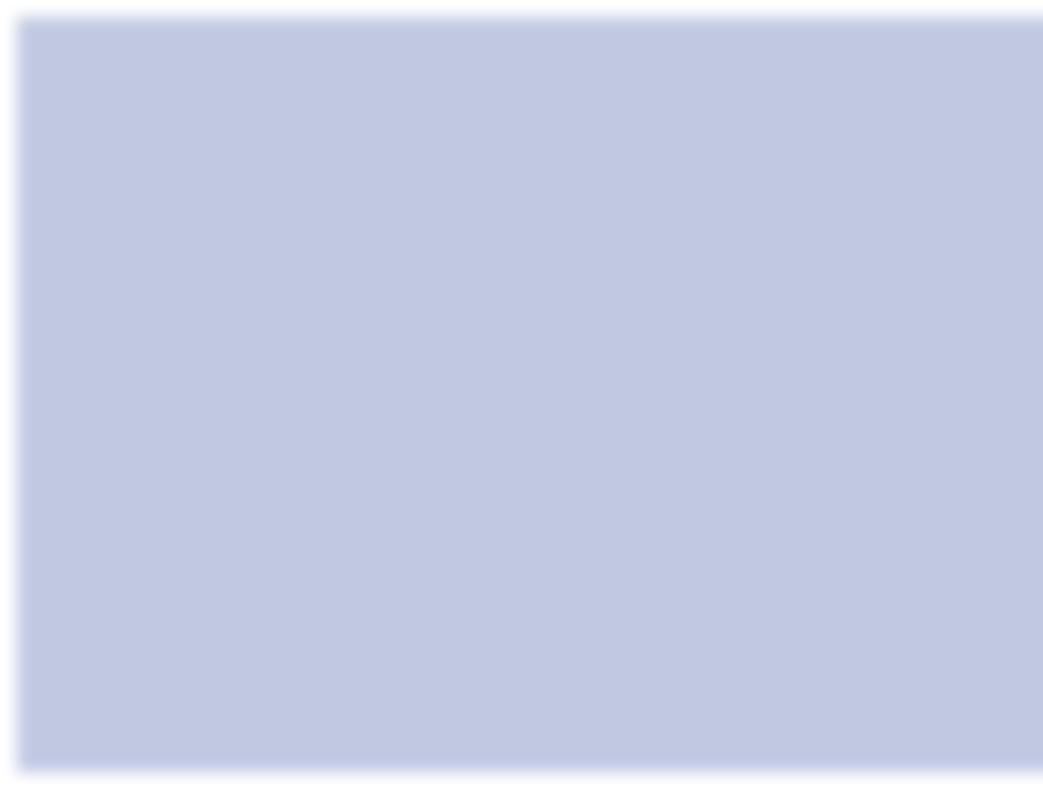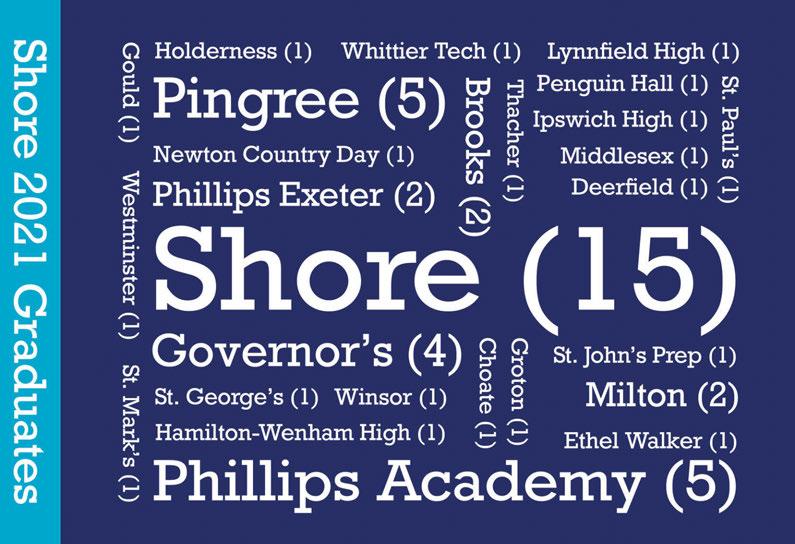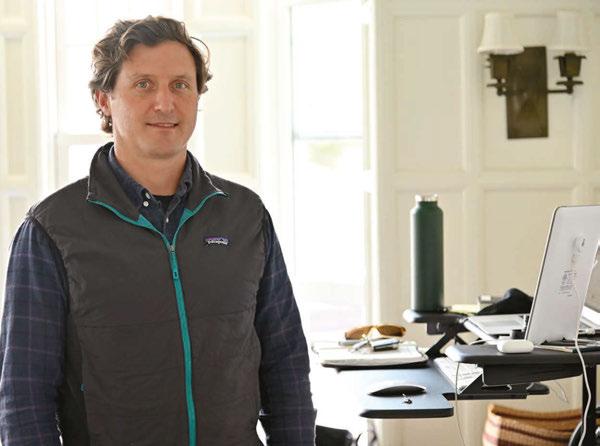
6 minute read
Students Find Secondary School Matches Despite Challenges

Students Find Secondary School Matches
Advertisement
Despite Challenges

This year, like every year, Shore families turned to the Secondary School Counseling Ofce as they faced the task of fnding an appropriate ft for their child’s next school. Unlike every other year, however, Shore families faced doing so in the midst of a pandemic. “Almost everything about this secondary school admissions season was diferent,” says Director of Secondary School Counseling Sander van Otterloo.
Fortunately, at least one thing remained the same this year: Shore’s success in fnding great secondary school matches for its graduates.
Still, the list of new hurdles brought about by the pandemic was long. For starters, families could not visit campuses to see schools in action, and in-person interviews were of the table, as well. Even counseling sessions with van Otterloo and Head of School Clair Ward had to be conducted virtually. “These factors compounded the difculty of what can be already a fraught fnancial and emotional decision,” says van Otterloo.
Adding to the challenge was a food of pandemic- inspired secondary school applications from the increased number of families in the public school system who became interested in independent schools for the frst time. “Most schools reported a 40% increase in applications over the previous year,” reports van Otterloo. Part of the extraordinary rise was due to another factor unique to this year: the SSAT became optional at nearly every school, after the Enrollment Management Association, the organization that administers the SSAT, tried to move its testing online same this year: Shore’s success in fnding great but faced difculty with the rollout. The optional secondary school matches for its graduates. test meant that many schools, particularly
Still, the list of new hurdles brought the most selective, received an additional boost in applications from students whose test scores normally would have been a barrier to entry. As if that weren’t enough, admissions decisions made by secondary schools at the very start of the pandemic in the spring of 2020 brought unintended consequences for this year’s applicants. Given the uncerbe already a fraught fnancial and emotional tainties around the early phases of COVID-19 in the United States, many independent
but faced di test meant that many schools, particularly the most selective, received an additional boost in applications from students whose test scores normally would have been a barrier to entry. secondary schools at the very start of the pandemic in the spring of 2020 brought unintended consequences for this year’s applicants. Given the uncer tainties around the early phases of COVID-19 Phillips Academy in the United States, many independent



schools expected to face unusually high rates of attrition, both among their enrolled students and among those who had just been accepted that spring. To mitigate this perceived risk, they overenrolled incoming classes. When the anticipated attrition never materialized, however, it made acceptance even more difcult for students seeking admission this year.
“All this is to say,” explains van Otterloo, “that all signs pointed to a potentially lower overall acceptance rate for Shore students applying to secondary schools.” And while the overall rate was indeed lower, surprisingly that wasn’t the end of the story: though they may have been accepted at fewer schools, about 75% of Shore students were accepted at their frst-choice school, an all-important statistic given the Secondary School Counseling Ofce’s emphasis on fnding the right ft for each child. Says Head of School Clair Ward, “This is a testament to our eforts on behalf of each individual child. To have the resources to successfully advocate for our students with the admissions ofcers of some of the most competitive secondary schools in the country is an extraordinary advantage for us.”
There was more good news. Some 15 eighth graders chose to return for Shore’s ninth grade program— double the enrollment during the 2020-2021 school year. “It was an easy decision for many families who just felt they couldn’t get an adequate look at other schools this year, and instead chose the strong program they were already familiar with,” they were already says van Otterloo. says van Among those families Among who did apply out, van who Otterloo is pleased to note Otterloo that students earned that acceptances at a wider acceptances range of schools than inrange previous years. Whereas previous last year, for example,last year, some 60 students ended upsome 60 at 18 independent schools, thisat 18 independent Pingree School year’s smaller group of applicants found homes at 23. “To year’s smaller cants found see that number increase so signifcantly in a year is exciting,” attests van Otterloo. “It means our approach to fnding a ‘custom’ ft is working.” When families consider a wider range of options, especially by looking outside of the most popular schools in the immediate region, it’s easier for the Secondary School Counseling Ofce to recommend the best school ft for each child.
Another bright spot this year, according to van Otterloo, was refning the Secondary School Counseling Ofce’s approach to communicating with families. “Storytelling became a bigger part of the job than ever,” he says. “I have always told families that


Director of Secondary School Counseling Sander van Otterloo ’91
what I’m trying to do when presenting a Shore student to an admissions ofcer is tell their story. But this year it was more than that. Because of the pandemic, I had to tell the story of the schools themselves to a lot of families. It’s easy to look at the website and fnd the numbers. But it’s another thing to know how those numbers are refected in a student’s daily experience on campus. So this year I spent a lot of time showing families how they could think more deeply about all the diferent ways a school can support their child.”
Also successful was a series of smaller Zoom conversations with admissions directors from a group of schools, typically two or three. “I invited them to have direct conversations with families so they could get to know the schools better. Families could then just drop into these sessions and ask any questions on their mind directly to admissions directors.” The six well-attended conversations were part of a communications plan that included more touchpoints than ever for families—particularly later in the secondary school search process. “Interestingly, I may have done more counseling after families received their acceptances this year, because there were no in-person revisit days at the schools that admitted their child. It made fnding the right ft a real puzzle, and the result was more conversation post-acceptance than I’ve ever had.”
Looking back at what made this year uniquely challenging—but also uniquely successful—van Otterloo is hesitant when it comes to predicting what changes will stick around in the future. One thing of which he is certain: the sense of relief at having faced a one-of-akind year and emerged at the end of it with such strong results for Shore students.










